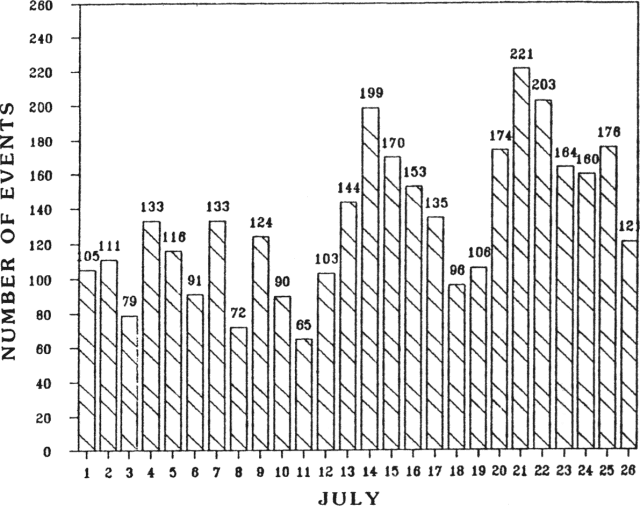Report on Poas (Costa Rica) — July 1989
Scientific Event Alert Network Bulletin, vol. 14, no. 7 (July 1989)
Managing Editor: Lindsay McClelland.
Poas (Costa Rica) Strong fumaroles in crater lake; seismicity increases
Please cite this report as:
Global Volcanism Program, 1989. Report on Poas (Costa Rica) (McClelland, L., ed.). Scientific Event Alert Network Bulletin, 14:7. Smithsonian Institution. https://doi.org/10.5479/si.GVP.SEAN198907-345040
Poas
Costa Rica
10.2°N, 84.233°W; summit elev. 2697 m
All times are local (unless otherwise noted)
July activity was similar to that of June. The level of the crater lake had lowered about 1 m. Intense sulfur-rich fumarolic activity occurred from four principal vents within the lake, three on the N side and one in the SE. Sulfur cones had grown at the N-central and SE vents, small sulfur flows had emerged from the NE vent, and lakes of molten brownish orange sulfur were present at other sites. Pyroclastic sulfur and sublimates carpeted the bottom of the crater lake. Bubblings of mud occurred throughout the lake from fumaroles below its surface. Activity on the 1953-55 [dome] remained unchanged, characterized by low-temperature fumaroles.
The number of microseismic events recorded at the nearby Red Sismológica Nacional station VPS-2 increased in July, totaling 3,442 through the 26th, a mean of 132/day (figure 20). Seismicity was dominated by B-type shocks, with some well-defined tremor episodes and four very low-magnitude A-type events. The most active day was 21 July, with 221 volcanic microearthquakes.
 |
Figure 20. Number of seismic events/day at Poás, recorded by Red Sismológica Nacional station VPS-2, July 1989. Courtesy of G. Soto. |
Geological Summary. The broad vegetated edifice of Poás, one of the most active volcanoes of Costa Rica, contains three craters along a N-S line. The frequently visited multi-hued summit crater lakes of the basaltic-to-dacitic volcano are easily accessible by vehicle from the nearby capital city of San José. A N-S-trending fissure cutting the complex stratovolcano extends to the lower N flank, where it has produced the Congo stratovolcano and several lake-filled maars. The southernmost of the two summit crater lakes, Botos, last erupted about 7,500 years ago. The more prominent geothermally heated northern lake, Laguna Caliente, is one of the world's most acidic natural lakes, with a pH of near zero. It has been the site of frequent phreatic and phreatomagmatic eruptions since an eruption was reported in 1828. Eruptions often include geyser-like ejections of crater-lake water.
Information Contacts: Gerardo J. Soto, Mario Fernández, and Héctor Flores, UCR.

